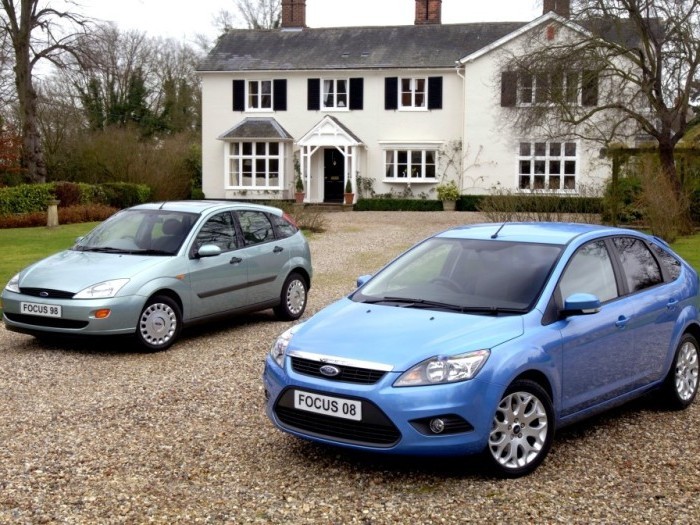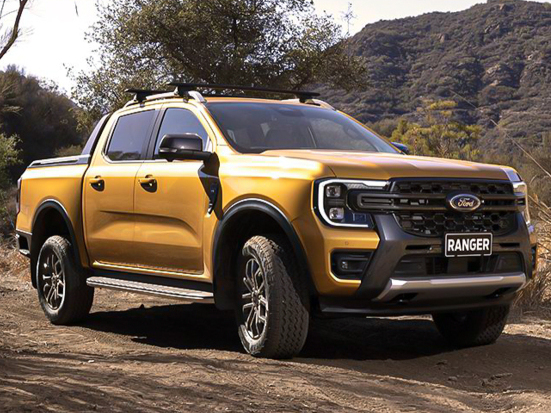Q
Is Ford Focus sedan a good choice?
Yes, Ford Focus sedan can be regarded as a good car. It has sophiscated manufacturing craftsmanship and a good reputation for reliability. It is equipped with a 1.5-liter EcoBoost engine, with a top speed of up to 222 km/h and an acceleration time from 0 to 100 km/h of 8.6 seconds. It strikes a good balance between performance and fuel economy, with an official combined fuel consumption of 5.6 liters per 100 kilometers. It is equipped with a series of standard safety features, such as multiple airbags, Anti-lock Braking System (ABS) and Electronic Stability Control, which enhance driving safety. Inside the car, there are facilities like a dual-zone automatic air - conditioning system, providing a comfortable driving and riding environment. The car's infotainment system is easy to operate. In addition, the Ford Focus has a spacious trunk with a volume of up to 421 liters.
However, like any vehicle, it also has its drawbacks. Some users may find that its fuel economy is not as good as some of its competitors in this segment, and the rear - seat space might be a bit cramped for some people. But overall, it's a good choice for those looking for a reliable and well - equipped compact sedan.
Special Disclaimer: This content is published by users and does not represent the views or position of PCauto.
Related Q&A
Q
What's the fuel consumption of Ford Focus?
The official combined fuel consumption of the 2017 Ford Focus 4-door sedan with a 1.5-liter EcoBoost engine, Titanium Plus Edition, is 5.6 liters per 100 kilometers. This figure is measured under specific test conditions stipulated by the manufacturer. However, in real-world driving, the actual fuel consumption can vary due to multiple factors.
For instance, driving style has a significant impact on fuel consumption. An aggressive driving style with frequent rapid acceleration and hard braking usually leads to higher fuel consumption, while smooth and constant-speed driving helps save fuel. Road conditions also play a role. Compared with driving on a flat highway with light traffic, driving on hills or in heavy traffic typically increases fuel consumption.
In addition, vehicle load, tire pressure, and the use of accessories such as the air - conditioning system can all affect the actual fuel consumption of the Ford Focus.
Q
What's the service life of Ford Focus' petrol engine?
The service life of the gasoline engine in the Ford Focus can be different. Generally speaking, if properly maintained, the service life of gasoline engine can last for more than 150,000 to 200,000 miles (about 240,000 to 320,000 kilometers) or even longer. The Ford Focus 1.5 EcoBoost Titanium+ is equipped with a 1498 - cc gasoline engine.
Regular oil changes are crucial because fresh oil lubricates the engine components, reducing friction and wear. Replacing filters, such as the air filter and fuel filter, also enables the engine to take in clean air and get the proper fuel mixture. Timely replacement of belts and hoses that age over time helps prevent unexpected breakdowns. Maintaining good driving habits is also important. Aggressive driving with sudden acceleration and hard braking will damage the engine, while smooth driving can extend the engine's service life. Additionally, following the manufacturer's maintenance schedule for the engine (for the Ford Focus, it might be maintenance at regular intervals of mileage or time) can ensure the engine stays in good working condition over the long term.
Q
Which one is better, Honda Civic or Ford Focus?
The Honda Civic and the Ford Focus each have their own advantages, making it difficult to simply judge which one is better. In terms of appearance, the front end of the Ford Focus has a dynamic design. Its large - sized aluminum alloy wheels are well - matched with the sporty taillight group, giving the car an overall fashionable and tech - savvy look. On the other hand, the Honda Civic may have a more simple and smooth shape.
When it comes to the interior, the Focus' 13.2 - inch floating central control screen creates an excellent technological atmosphere. It also comes with a large - sized sunroof, automatic air - conditioning and other complete configurations. The Civic's interior perhaps focuses more on the balance between comfort and practicality.
In terms of power, the Focus offers a variety of power options, including different turbocharged engines, providing plenty of driving fun. The Civic's power performance can also meet the needs of daily driving, and it may perform well in terms of fuel economy.
The prices of the two cars also vary depending on the specific models and configurations. It is recommended that you go to a dealership to test - drive these two models in person, experience their actual driving feelings, and then select the most suitable model for yourself based on factors such as your budget and your preferences for the appearance and interior.
Q
Is Ford Focus smaller than Corolla?
The 2017 Ford Focus Sedan 1.5 EcoBoost Titanium+ measures 4,534mm in length, 1,823mm in width, and 1,484mm in height, with a wheelbase of 2,648mm. The dimensions of the Corolla vary depending on the version and year. Generally, its length ranges from 4,300mm to 4,600mm, width from 1,700mm to 1,800mm, height from 1,450mm to 1,500mm, and wheelbase typically from 2,600mm to 2,700mm. As we can see, the Ford Focus is bigger than the common Corolla in length, width, height, and also longer in wheelbase.
However, the interior space of a car isn't solely determined by its exterior dimensions. Factors such as the in - car layout design also play a role in the actual space experience. Moreover, there are differences in the dimensions among different Corolla models. A detailed comparison requires the accurate parameters of the actual models. But when compared with the above - mentioned models, the Ford Focus has larger overall dimensions.
Q
Which one is better, Mazda 3 or Ford Focus?
Both Mazda 3 and Ford Focus have their own advantages, so which one is better depends on individual needs and preferences. In terms of price, if you have a limited budget, the Focus might be more suitable as it is relatively affordable. When it comes to configuration, the Mazda 3 has more abundant safety features. Even the base - model is equipped with a tire pressure monitoring system and a vehicle stability control system. Regarding power performance, the Focus is powered by a 1.5 - liter naturally - aspirated engine, while the Mazda 3 offers a choice between a 1.5L and a 1.4T engine, and the 1.4T engine provides stronger power. In terms of exterior design, the Focus has a more masculine look, while the Mazda 3 is more appealing to women. Moreover, the seams on the Mazda 3's center console are more delicate. In terms of space, some testers think that the Mazda 3 has a slight edge in headroom and legroom. All in all, if you focus on price and practicality, the Focus is a good option. However, if you prefer rich configurations and strong power, the Mazda 3 may be a better choice.
Q
What is the fuel economy of Ford Focus?
The official fuel consumption of the 2017 Ford Focus sedan 1.5-liter EcoBoost Titanium Plus Edition is 5.6 liters per 100 kilometers. This figure represents the combined fuel consumption under standard test conditions. In real-world driving, the fuel consumption may vary, which can be affected by factors such as driving style, road conditions, and vehicle load. For example, an aggressive driving style with rapid acceleration and hard braking may increase fuel consumption, while a smoother and more stable driving style may make the actual fuel consumption closer to the official data. Additionally, using features such as the air conditioner and having an excessive vehicle load can also affect the car's fuel consumption. The Focus's fuel consumption of 5.6 liters per 100 kilometers makes it a relatively fuel-efficient model in the compact car segment, helping car owners reduce their vehicle usage costs.
Q
Which model of Ford Focus is the best?
As the criteria for "the best" vary from different people, so it's quite difficult to directly determine which model is the best. Take the 2017 Ford Focus Sedan 1.5 EcoBoost Titanium+ as an example. It is equipped with rich configurations. In terms of power, the 1.5 - liter engine has a maximum horsepower of 182PS. The maximum speed can reach 222km/h, and it can accelerate from 0 to 100km/h in 8.6 seconds. Its power output has certain advantages among cars in the same class. Regarding safety features, it is standard - equipped with a series of safety systems such as ABS anti - lock brakes, vehicle stability control, and lane - change assist, and also has six airbags to comprehensively ensure the safety of drivers and passengers. There are also quite a few comfort features inside the car, like the dual - zone automatic air - conditioning in the front row and Sony speakers. However, if consumers pay more attention to fuel economy, its official combined fuel consumption of 5.6L/100km is quite good. If they prefer space, its 421L trunk volume is just average. So, the best model depends on individual's preferences.
Q
Is Ford Focus a small or mid-size car?
The Ford Focus is a small car, specifically a C-segment or compact sedan. It has a body length of 4,534 millimeters, a width of 1,823 millimeters, a height of 1,484 millimeters, and a wheelbase of 2,648 millimeters. These dimensions are typical specifications for a compact sedan. In the automotive classification, compared with mid-size or large vehicles, compact sedans are known for their relatively small size, which makes them easier to be driven in the city.
Compact sedans like the Ford Focus are popular among many consumers for their affordable price, good fuel economy, and easy parking. The Ford Focus is an excellent choice for daily commuting and city driving. And as a compact sedan, it also offers an ample interior space and features, such as a 55-liter fuel tank and 421 liters of trunk space.
Q
How far can a Ford Focus travel on an empty fuel tank?
Generally speaking, it's not recommended to drive your car until the fuel runs out completely, as this can potentially damage components like the fuel pump. However, in theory, if we estimate based on the information of the 2017 Ford Focus Sedan 1.5 EcoBoost Titanium+, its fuel tank capacity is 55 liters, and the official combined fuel consumption is 5.6 liters per 100 kilometers. Calculated at this fuel - consumption level, the theoretical driving range of this car when the tank is full is about 982 kilometers.
However, the actual range is affected by various factors. For example, driving style is an important factor. Frequent hard acceleration and sudden braking increase fuel consumption and reduce the range. Road conditions also play a role. Driving in congested traffic or on mountain roads can cause the fuel consumption to go up. Vehicle load is another factor. Having more passengers or carrying a large amount of items in the car will make it "thirstier" for fuel. So, in actual use, the range of this car will be less than the theoretical value, and the specific figure depends on the actual driving conditions.
Q
What is special about Ford Focus?
The Ford Focus has many distinctive features. It is equipped with a 1.5-liter EcoBoost engine that strikes a great balance between performance and efficiency. The maximum speed can reach up to 222 km/h, and the official 0 - 100 km/h acceleration time is 8.6 seconds. Meanwhile, the official combined fuel consumption is relatively low, at 5.6 liters per 100 kilometers.
In terms of safety, it is equipped with a series of standard features, such as six airbags, an Anti-lock Braking System (ABS), a Vehicle Stability Control system, and a variety of active safety systems. Comfort and convenience are also well - guaranteed. It offers a dual - zone automatic air - conditioning system and a Sony audio system for the front row, along with keyless operation and a single sunroof.
The interior design focuses on ergonomics, creating a "flight cockpit" feel. The 60:40 split - folding rear seats enhance the vehicle's practicality. Moreover, the exterior features a modern and dynamic design with sharp lines, which has won the favor of many consumers.
Popular Cars
Model Year
Car Compare
Car Photo
Latest Q&A
Q
How does the 2022 Odyssey compare to other minivans?
The 2022 Honda Odyssey stands out among mainstream family MPVs with several competitive advantages. Its 3.5L V6 engine delivers 280 horsepower, paired with a 10-speed automatic transmission that offers smoother shifts and better fuel efficiency than many rivals still using 6 or 8-speed gearboxes.
The magic seat design is a game-changer—the second row slides sideways up to 16 cm, while the third row folds flat with one-touch functionality, making seat reconfiguration far more flexible than conventional MPVs. Perfect for families constantly juggling cargo and passenger needs.
On the safety front, the Odyssey comes standard with Honda Sensing, including adaptive cruise control and lane-keeping assist—features that often cost extra in competing models. For entertainment, it’s equipped with a rear-seat entertainment screen and CabinTalk, solving the classic "backseat shout" problem on long trips.
A standout detail? The low floor height—12-15 cm lower than most MPVs—makes entry and exit noticeably easier for kids and elderly passengers. While many MPVs prioritize space at the expense of driving dynamics, the Odyssey’s double-wishbone rear suspension (a rarity in this segment) actually improves handling stability.
Maintenance intervals align with local habits—recommended every 10,000 km or 6 months—keeping ownership costs reasonable. All in all, it’s a thoughtful package that doesn’t force families to compromise.
Q
Is there a recall on Honda Odyssey 2022?
At present, Honda has not issued any recall notice for the 2022 Odyssey. This model has shown good overall reliability performance in the local market. However, it is recommended that car owners regularly check the latest safety notices through Honda's official website or authorized service centers, as there are occasional service activities for specific components worldwide. For example, some markets have undergone preventive maintenance for the electric tailgate control module or sliding door sensor. For the daily maintenance of MPV models, special attention should be paid to cleaning the electric sliding door tracks and updating the multimedia system software, which can affect the user experience. If any abnormal conditions are found in the vehicle, such as warning lights on the dashboard or electronic device failure prompts, it is best to contact the nearest authorized repair point for professional inspection as soon as possible, after all, the seven seater model has more complex electronic devices than ordinary sedans. In addition, it is recommended that car owners develop the habit of regularly checking the condition of the vehicle, including tire wear, brake system status, etc. These large family cars usually carry heavy loads, and the wear and tear of chassis components will be relatively faster.
Q
What should I pay for a 2022 Honda Odyssey?
The used car price of a 2022 Honda Odyssey can vary depending on its condition, mileage, trim level, and warranty coverage. Typically, you can expect prices to range between RM150,000 to RM220,000, with well-maintained, low-mileage higher-spec models leaning toward the upper end. On the other hand, base trims or those with higher mileage will be more affordable.
Before buying, it’s always a good idea to get a thorough inspection from an authorized used car dealer or a trusted seller to check for accident history and mechanical issues. The Odyssey is a popular family MPV, known for its spacious cabin, comfortable ride, and reliable performance—especially its versatile Magic Seat system and efficient powertrain, making it great for long trips.
When shopping, don’t just focus on the price—consider warranty coverage and after-sales service to avoid future headaches. If your budget allows, you might also want to explore newer models or even a brand-new unit for better features and longer warranty protection.
Q
What are common problems with the 2022 Odyssey Elite?
The 2022 Odyssey Elite delivers solid performance as a premium minivan, though some owners report recurring quirks. The infotainment system occasionally freezes or lags—particularly when using Apple CarPlay or Android Auto—often requiring a reboot to resolve. Another hiccup involves the power sliding doors' sensors misreading obstacles during wet weather, usually fixed by wiping the sensors clean.
Mechanically, a handful of drivers notice slight low-speed gearshift hesitation from the 9-speed transmission, but a dealership software tweak typically smooths it out. While the 3.5L V6 packs plenty of punch, stop-and-go traffic tanks fuel efficiency; keeping air filters and spark plugs in check helps. Honda did improve cabin quietness over the previous gen, though tire hum still reaches the third row at highway speeds—swapping to touring tires helps if you're picky about noise.
One nitpick: The Honda Sensing suite's automatic braking tends to be jumpy in crawling traffic, triggering false alerts. You can dial down its sensitivity via the touchscreen. Pro tip: Given the Odyssey's heft, brake pads wear faster—stick to 10,000-mile inspections.
Q
How long will a 2022 Honda Odyssey last?
The 2022 Honda Odyssey can typically last between 200,000 to 300,000 kilometers—or even longer—with proper maintenance and reasonable use. Its actual lifespan depends on driving habits, maintenance frequency, and road conditions.
Under the hood, the Odyssey comes with Honda’s proven 2.4L i-VTEC engine or a hybrid system, both known for their durability. Staying on top of oil changes, transmission fluid swaps, and suspension upkeep will go a long way in keeping it running smoothly. The body has solid rust protection, but if you’re near the coast, an extra undercoat wouldn’t hurt to fight off salt and humidity.
One thing to note: The hybrid’s battery pack usually lasts 8-10 years, though replacement costs have been dropping. Every 50,000 km, it’s smart to check the drivetrain and steering system, plus replace wear-and-tear parts like the timing chain when needed. Easy driving—avoiding hard acceleration and heavy loads—helps preserve the engine and transmission.
Resale value is strong for an MPV, especially with clean maintenance records. Stick to the service schedule, and most owners can get 15+ years out of it without major repairs.
View MoreRelated News

Ford Focus will cease production in 2025, shifting strategic emphasis towards electrification
Kevin WongMar 10, 2025

Ford Focus is about to cease production in November and may return in 2027 in the form of an SUV.
WilliamSep 15, 2025

2025 Ford Ranger WildTrak launched, the most powerful diesel version in the Ranger lineup
MichaelAug 25, 2025

Is the Ford Ranger V6 about to enter Malaysia?
LienAug 13, 2025

Reviewing the Ford Ranger: The Dual Advantages of Rugged Appearance and Powerful Performance
Kevin WongApr 21, 2025
View More

















Pros
Cons